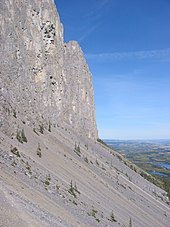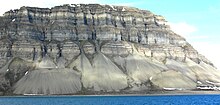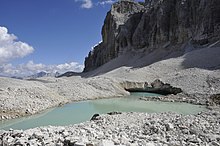Scree

Screeis a collection of brokenrockfragments at the base of acliffor other steep rocky mass that has accumulated through periodicrockfall.Landforms associated with these materials are often calledtalus deposits.Talus deposits typically have a concave upwards form, where the maximum inclination corresponds to theangle of reposeof the meandebrisparticle size. The exact definition of scree in theprimary literatureis somewhat relaxed, and it often overlaps with bothtalusandcolluvium.[1]
The termscreecomes from theOld Norseterm forlandslide,skriða,[2]while the termtalusis a French word meaning a slope or embankment.[3][4]
In high-altitudearcticandsubarcticregions, scree slopes and talus deposits are typically adjacent to hills and river valleys. These steep slopes usually originate from late-Pleistoceneperiglacialprocesses.[5]Notable scree sites in Eastern North America include the Ice Caves atWhite Rocks National Recreation Areain southern Vermont andIce Mountainin eastern West Virginia[6]in theAppalachian Mountains.Screes are most abundant in thePyrenees,Alps,Variscan,Apennine,Orocantabrian, andCarpathian Mountains,Iberian peninsula,and Northern Europe.[7]
Description
[edit]The termscreeis applied both to an unstable steep mountain slope composed of rock fragments and other debris, and to the mixture of rock fragments and debris itself.[8][9][10]It is loosely synonymous withtalus,material that accumulates at the base of a projecting mass of rock,[9][11]ortalus slope,a landform composed of talus.[12]The termscreeis sometimes used more broadly for any sheet of loose rock fragments mantling a slope, whiletalusis used more narrowly for material that accumulates at the base of a cliff or other rocky slope from which it has obviously eroded.[9]
Scree is formed by rockfall,[10][13]which distinguishes it fromcolluvium.Colluvium is rock fragments or soil that is deposited byrainwash,sheetwash,or slowdownhill creep,usually at the base of gentle slopes or hillsides.[14]However, the termsscree,talus,[9][10]and sometimescolluvium[1]tend to be used interchangeably. The termtalus depositis sometimes used to distinguish the landform from the material of which it is made.[15]
Scree slopes are often assumed to be close to theangle of repose.This is the slope at which a pile of granular material becomes mechanically unstable. However, careful examination of scree slopes shows that only those that are either rapidly accumulating new material, or are experiencing rapid removal of material from their bases, are close to the angle of repose. Most scree slopes are less steep, and they often show a concave shape, so that the foot of the slope is less steep than the top of the slope.[16][17]
Scree with large, boulder-sized rock fragments may formtalus caves,or human-sized passages formed in-between boulders.[18]
Formation
[edit]
The formation of scree and talus deposits is the result of physical and chemicalweatheringacting on a rock face, anderosive processestransporting the material downslope.
There are five main stages of scree slope evolution: (1) accumulation, (2) consolidation, (3) weathering, (4) encroaching vegetation, and finally, (5) slope degradation.
Scree slopes form as a result of accumulated loose,coarse-grainedmaterial. Within the scree slope itself, however, there is generally good sorting of sediment by size: larger particles accumulate more rapidly at the bottom of the slope.[19]Cementationoccurs asfine-grainedmaterial fills in gaps between debris. The speed of consolidation depends on the composition of the slope;clayeycomponents will bind debris together faster thansandyones. Shouldweatheringoutpace the supply of sediment, plants may take root. Plant roots diminishcohesiveforces between the coarse and fine components, degrading the slope.[20]The predominant processes thatdegradea rock slope depend largely on the regionalclimate(see below), but also on the thermal and topographic stresses governing the parent rock material. Example process domains include:
Physical weathering processes
[edit]
Scree formation is commonly attributed to the formation of ice within mountain rock slopes. The presence ofjoints,fractures,and other heterogeneities in the rock wall can allowprecipitation,groundwater,andsurface runoffto flow through the rock. If the temperature drops below the freezing point of the fluid contained within the rock, during particularly cold evenings, for example, this water can freeze. Since water expands by 9% when it freezes, it can generate large forces that either create new cracks or wedge blocks into an unstable position. Special boundary conditions (rapid freezing and water confinement) may be required for this to happen.[21]Freeze-thawscree production is thought to be most common during the spring and fall, when the daily temperatures fluctuate around the freezing point of water, and snow melt produces ample free water.
The efficiency of freeze-thaw processes in scree production is a subject of ongoing debate. Many researchers believe that ice formation in large open fracture systems cannot generate high enough pressures to force the fracturing apart of parent rocks, and instead suggest that the water and ice simply flow out of the fractures as pressure builds.[22]Many argue thatfrost heaving,like that known to act in soil inpermafrostareas, may play an important role in cliff degradation in cold places.[23][24]
Eventually, a rock slope may be completely covered by its own scree, so that production of new material ceases. The slope is then said to be "mantled" with debris. However, since these deposits are still unconsolidated, there is still a possibility of the deposit slopes themselves failing. If the talus deposit pile shifts and the particles exceed the angle of repose, the scree itself may slide and fail.
Chemical weathering processes
[edit]Phenomena such asacid rainmay also contribute to the chemical degradation of rocks and produce more loose sediments.
Biotic weathering processes
[edit]Biotic processes often intersect with both physical and chemical weathering regimes, as the organisms that interact with rocks can mechanically or chemically alter them.
Lichenfrequently grow on the surface of, or within, rocks. Particularly during the initial colonization process, the lichen often inserts itshyphaeinto smallfracturesor mineralcleavage planesthat exist in the host rock.[25]As the lichen grows, the hyphae expand and force the fractures to widen. This increases the potential of fragmentation, possibly leading to rockfalls. During the growth of the lichenthallus,small fragments of the host rock can be incorporated into the biological structure and weaken the rock.
Freeze-thaw actionof the entire lichen body due to microclimatic changes in moisture content can alternately cause thermal contraction and expansion,[25]which also stresses the host rock. Lichen also produce a number oforganic acidsas metabolic byproducts.[25]These often react with the host rock, dissolving minerals, and breaking down the substrate into unconsolidated sediments.
Interactions with surrounding landscape
[edit]Scree often collects at the base of glaciers, concealing them from their environment. For example,Lech dl Dragon,in theSella groupof theDolomites,is derived from the melting waters of a glacier and is hidden under a thick layer of scree. Debris cover on a glacier affects the energy balance and, therefore, the melting process.[26][27]Whether the glacier ice begins melting more rapidly or more slowly is determined by the thickness of the layer of scree on its surface.
The amount of energy reaching the surface of the ice below the debris can be estimated via the one-dimensional, homogeneous material assumption ofFourier's law:[27]
,
wherekis thethermal conductivityof the debris material,Tsis the ambient temperature above the debris surface,Tiis the temperature at the lower surface of the debris, anddis the thickness of the debris layer.

Debris with a low thermal conductivity value, or a highthermal resistivity,will not efficiently transfer energy through to the glacier, meaning the amount of heat energy reaching the ice surface is substantially lessened. This can act toinsulatethe glacier from incoming radiation.
Thealbedo,or the ability of a material to reflect incoming radiation energy, is also an important quality to consider. Generally, the debris will have a lower albedo than the glacier ice it covers, and will thus reflect less incoming solar radiation. Instead, the debris will absorb radiation energy and transfer it through the cover layer to the debris-ice interface.
If the ice is covered by a relatively thin layer of debris (less than around 2 centimeters thick), the albedo effect is most important.[28]As scree accumulates atop the glacier, the ice's albedo will begin to decrease. Instead, the glacier ice will absorb incoming solar radiation and transfer it to the upper surface of the ice. Then, the glacier ice begins to absorb the energy and uses it in the process of melting.
However, once the debris cover reaches 2 or more centimeters in thickness, the albedo effect begins to dissipate.[28]Instead, the debris blanket will act to insulate the glacier, preventing incoming radiation from penetrating the scree and reaching the ice surface.[28]In addition to rocky debris, thick snow cover can form an insulating blanket between the cold winter atmosphere andsubniveanspaces in screes.[29]As a result, soil, bedrock, and alsosubterraneanvoids in screes do not freeze at high elevations.
Microclimates
[edit]A scree has many small interstitial voids, while anice cavehas a few large hollows. Due to cold air seepage and air circulation, the bottom of scree slopes have a thermal regime similar to ice caves.
Because subsurface ice is separated from the surface by thin,permeablesheets of sediment, screes experience cold air seepage from the bottom of the slope where sediment is thinnest.[6]This freezing circulating air maintains internal scree temperatures 6.8-9.0 °C colder than external scree temperatures.[30]These <0 °C thermal anomalies occur up to 1000m below sites with mean annual air temperatures of 0 °C.
Patchypermafrost,which forms under conditions <0 °C, probably exists at the bottom of some scree slopes despite mean annual air temperatures of 6.8–7.5 °C.[30]
Biodiversity
[edit]During thelast glacial period,a narrow ice-free corridor formed in theScandinavianice sheet,[31]introducingtaigaspecies to the terrain. Theseborealplants and animals still live in modernalpineandsubarctictundra,as well as high-altitudeconiferousforests andmires.[32][33]
Screemicroclimatesmaintained by circulating freezing air createmicrohabitatsthat support taiga plants and animals that could not otherwise survive regional conditions.[6]
ACzech Republic Academy of Sciencesresearch team led byphysical chemistVlastimil Růžička, analyzing 66 scree slopes, published a paper inJournal of Natural Historyin 2012, reporting that: "This microhabitat, as well as interstitial spaces between scree blocks elsewhere on this slope, supports an important assemblage of boreal andarcticbryophytes,pteridophytes,andarthropodsthat are disjunct from their normal ranges far to the north. This freezing scree slope represents a classic example of a palaeorefugiumthat significantly contributes to [the] protection and maintenance of regional landscapebiodiversity."[6]
Ice Mountain,a massive scree inWest Virginia,supports distinctly different distributions of plant and animal species than northern latitudes.[6]
Scree running
[edit]Scree running is the activity of running down a scree slope; which can be very quick, as the scree moves with the runner. Some scree slopes are no longer possible to run, because the stones have been moved towards the bottom.[34][35][36]
See also
[edit]- Blockfield- similar to talus and scree slopes, formed by frost weather instead of mass wastings
- Fellfield
- Lava stringer– Type of rock formation
- Mass wasting– Movement of rock or soil down slopes
- Stratified slope deposit
- Weathering– Deterioration of rocks and minerals through exposure to the elements
- Scree plot
References
[edit]- ^abLandslides: investigation and mitigation.Turner, A. Keith, 1941-, Schuster, Robert L. Washington, D.C.: National Academy Press. 1996.ISBN0-309-06208-X.OCLC33102185.
{{cite book}}:CS1 maint: others (link) - ^Harper, Douglas."scree".Online Etymology Dictionary.Retrieved2006-04-20.
- ^Harper, Douglas."talus".Online Etymology Dictionary.Retrieved2008-12-01.
- ^"Talus".bab.la language portal.Retrieved2011-12-10.
- ^Růžička, Vlastimil; Hajer, Jaromír (1996-12-01)."Spiders (Araneae) of stony debris in North Bohemia".Arachnologische Mitteilungen.12:46–56.doi:10.5431/aramit1202.ISSN1018-4171.
- ^abcdeRůžička, Vlastimil; Zacharda, Miloslav; Němcová, Lenka; Šmilauer, Petr; Nekola, Jeffrey C. (September 2012)."Periglacial microclimate in low-altitude scree slopes supports relict biodiversity".Journal of Natural History.46(35–36): 2145–2157.doi:10.1080/00222933.2012.707248.ISSN0022-2933.S2CID86730753.
- ^Valachovič, Milan; Dierssen, Klaus; Dimopoulos, Panayotis; Hadač, Emil; Loidi, Javier; Mucina, Ladislav; Rossi, Graziano; Tendero, Francisco Valle; Tomaselli, Marcello (June 1997)."The vegetation on screes—A synopsis of higher syntaxa in Europe".Folia Geobotanica et Phytotaxonomica.32(2): 173–192.doi:10.1007/BF02803739.ISSN0015-5551.S2CID223142.
- ^"scree".Oxford English Dictionary(Online ed.).Oxford University Press.(Subscription orparticipating institution membershiprequired.)
- ^abcdJackson, Julia A., ed. (1997). "scree".Glossary of geology(Fourth ed.). Alexandria, Virginia: American Geological Institute.ISBN0922152349.
- ^abcAllaby, Michael (2013). "scree".A dictionary of geology and earth sciences(Fourth ed.). Oxford: Oxford University Press.ISBN9780199653065.
- ^Jackson 1997,"talus".
- ^Thornbury, William D. (1969).Principles of geomorphology(2d ed.). New York: Wiley. p. 66.ISBN0471861979.
- ^Blatt, Harvey; Middleton, Gerard; Murray, Raymond (1980).Origin of sedimentary rocks(2d ed.). Englewood Cliffs, N.J.: Prentice-Hall. p. 176.ISBN0136427103.
- ^Jackson 1997,"colluvium".
- ^Brody, A. G.; Pluhar, C. J.; Stock, G. M.; Greenwood, W. J. (1 May 2015). "Near-Surface Geophysical Imaging of a Talus Deposit in Yosemite Valley, California".Environmental & Engineering Geoscience.21(2): 111–127.doi:10.2113/gseegeosci.21.2.111.
- ^Statham, I. (July 1973). "Scree Slope Development under Conditions of Surface Particle Movement".Transactions of the Institute of British Geographers(59): 41–53.doi:10.2307/621711.JSTOR621711.
- ^Statham, Ian (January 1976). "A scree slope rockfall model".Earth Surface Processes.1(1): 43–62.doi:10.1002/esp.3290010106.
- ^"Talus Caves - Caves and Karst (U.S. National Park Service)".nps.gov.National Park Service.Retrieved16 July2024.
- ^Kirkby, M. J.; Statham, Ian (May 1975)."Surface Stone Movement and Scree Formation".The Journal of Geology.83(3): 349–362.Bibcode:1975JG.....83..349K.doi:10.1086/628097.ISSN0022-1376.S2CID129310011.
- ^Gerber, E.; Scheidegger, A. E. (May 1974)."On the dynamics of scree slopes".Rock Mechanics.6(1): 25–38.Bibcode:1974RMFMR...6...25G.doi:10.1007/BF01238051.ISSN0035-7448.S2CID129262031.
- ^Whalley, WB (1984). "Rockfalls". In Brunsden, D.; Prior, DB (eds.).Slope Instability.Chichester: John Wiley and Sons. pp. 217–256.
- ^Hallet, B (2006). "Why do freezing rocks break?".Science.314(5802): 1092–1093.doi:10.1126/science.1135200.PMID17110559.S2CID140686582.
- ^Walder, J; Hallet, B (1985). "A theoretical model of the fracture of rock during freezing".Geological Society of America Bulletin.96(3): 336–346.Bibcode:1985GSAB...96..336W.doi:10.1130/0016-7606(1985)96<336:ATMOTF>2.0.CO;2.
- ^Murton, JB; Peterson, R; Ozouf, J-C (2006). "Bedrock fracture by ice segregation in cold regions".Science.314(5802): 1127–1129.Bibcode:2006Sci...314.1127M.doi:10.1126/science.1132127.PMID17110573.S2CID37639112.
- ^abcJie, Chen; Blume, Hans-Peter (October 2002)."Rock-weathering by lichens in Antarctic: patterns and mechanisms".Journal of Geographical Sciences.12(4): 387–396.doi:10.1007/BF02844595.ISSN1009-637X.S2CID128666735.
- ^Benn, D. I.; Evans, D. J. A (2010).Glaciers and Glaciation, 2nd ed.London: Hodder-Arnold.ISBN9780340905791.
- ^abNakawo, M.; Young, G.J. (1981)."Field Experiments to Determine the Effect of a Debris Layer on Ablation of Glacier Ice".Annals of Glaciology.2:85–91.Bibcode:1981AnGla...2...85N.doi:10.3189/172756481794352432.ISSN0260-3055.
- ^abcöstrem, Gunnar (January 1959)."Ice Melting under a Thin Layer of Moraine, and the Existence of Ice Cores in Moraine Ridges".Geografiska Annaler.41(4): 228–230.doi:10.1080/20014422.1959.11907953.ISSN2001-4422.
- ^Wheeler, Ralph A. (June 1990)."Spiders Are Spiders…".Southern Medical Journal.83(6): 723.doi:10.1097/00007611-199006000-00037.ISSN0038-4348.PMID2356505.
- ^abZacharda, Miloslav; Gude, Martin; Růžička, Vlastimil (July 2007)."Thermal regime of three low elevation scree slopes in central Europe".Permafrost and Periglacial Processes.18(3): 301–308.doi:10.1002/ppp.598.S2CID129472548.
- ^Quaternary glaciations: extent and chronology.Ehlers, Jürgen, 1948-, Gibbard, Philip L. (Philip Leonard), 1949- (1st ed.). Amsterdam: Elsevier. 2004.ISBN0-08-047407-1.OCLC318641379.
{{cite book}}:CS1 maint: others (link) - ^Tallis, J. H. (1991).Plant community history: long-term changes in plant distribution and diversity(1st ed.). London: Chapman and Hall.ISBN0-412-30320-5.OCLC23255468.
- ^Hájková, Petra; Horsák, Michal; Hájek, Michal (2012-01-01),"2 Late-Glacial and Holocene history of the Western Carpathian calcareous fens",Calcareous Mires of Slovakia,KNNV Publishing, pp. 13–20,doi:10.1163/9789004277960_003,ISBN978-90-04-27796-0,retrieved2020-12-17
- ^Simpson, Peter."Scree running".Encyclopaedia of New Zealand.
- ^Short, David (2012-02-01)."Scree running madness".Wilderness.Retrieved2020-12-21.
- ^Nettleton, John."Scree Running".Wildlife Trust.Retrieved2020-12-21.

